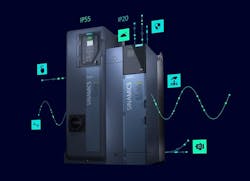R&D Spotlight: Certifiable Digital Twin Models for Power Drive Systems
At a Glance:
- Digital modeling and simulation have wide-ranging implications for product design and certification, including a more efficient pathway for product design and certification.
- Siemens SINAMICS G220 variable frequency drives are behind a digital twin model created for certifying a temperature rise test for a drive component.
- UL Solutions’ modeling and simulation services offers a proprietary verification and validation process to confirm the credibility of digital models for compliance.
- The takeaway: Integrated digital modeling and simulation can be used alongside traditional physical tests.
The manufacturing industry, a leader in digital twin adoption, is just beginning to grasp the value hidden behind digital twins.
This maturity was recently marked by the announcement that UL Solutions granted Siemens certification for using digital modeling and simulation to navigate compliance requirements of a power drive system. The development was not only a first for the German tech conglomerate but also represents a milestone in the field of digital twins.
Siemens approached UL Solutions back in 2018 for support with developing a digital model of the temperature rise test for a power drive component, according to Dr. Dirk Linzen, head of Test and Customer Escalation, Motion Control, Siemens AG. Siemens would leverage UL’s internal simulation and testing capabilities and the collaboration would culminate in the development of a verified simulation model for conducting temperature rise tests on a digital twin of a Siemens’ SINAMICS G220 variable frequency drive.
WATCH: Video Insights: Pioneering Digital Twins
A temperature rise test is required for certification to the second edition of UL/IEC 61800-5-1, the Standard for Adjustable Speed Electrical Power Drive Systems – Part 5-1: Safety Requirements – Electrical, Thermal and Energy. UL Solutions’ modeling and simulation services offers a proprietary verification and validation process to confirm the credibility of digital models for compliance.
The research project team, led by Linzen and consisting of a global team of Siemens and UL engineers, would need to prove the level of accuracy of their simulated models. “There was a lot of initial skepticism in the beginning, but also a ‘can do’ mentality,” said Linzen. “Now, we believe a verified and validated digital twin can deliver just as good results as a physical measurement—sometimes even better.”
What is a Digital Twin?
A digital twin is a virtual representation of a physical object. According to Siemens, its core component is a simulation model that incorporates all data and information from a physical object—in this case, the SINAMICS G220—to generate a virtual model of the behavior of the simulated object.
The physical object can be digitally connected to the digital twin throughout its lifecycle—during engineering, commissioning, operation and service—and can provide actionable insights across domains, from design and engineering to operations and maintenance.
What’s Unique about Certifying a Simulation Model on a Digital Twin?
A power drive system is a complex electronic product or system that consists of more than 1,200 components, with many critical components relating to temperature behavior. “Setting up and running a physical test, regardless of whether it is for the design validation or the type testing, is time-consuming, cost-intensive and often inconsistent,” said Dirk Mueller, manager, principal engineering, Energy and Industrial Automation at UL Solutions.
In the realm of electronic products, he said, components are subject to change and often lead to frequent repeats of the tests. “While running a digital model of the temperature test may be more complicated initially and requires additional physical validation testing, it pays off during the lifecycle of the product and across the entire product platform since the verified originally and validated model can be leveraged for design variances (within the agreed context of use) and design optimization during the lifecycle,” explained Mueller.
How Accurate are Simulated Models in the Design Phase?
Simulation is an iterative process of physical testing and validation, and requires updating of the digital model that will provide acceptance. The objective is for the simulation model to show an equivalent level of trustworthiness to the physical test.
“UL Solutions’ model verification and validation program mirrors the requirements of physical tests like ISO 17025 in the digital world," said Mueller. “Close collaboration among the different engineering disciplines, including the product domain experts, the simulation engineer and the certification/compliance manager, is critical to help ensure a product going to market meets safety requirements.”
READ MORE: Digital Twins: Designing Virtual Replicas of Infrastructure Projects
That said, using simulation without the proper parameters in the design phase is simultaneously a challenge and an opportunity. “Let’s say a new design will be investigated based upon an existing and validated model of the previous generation with limited modification,” explained Mueller. “It may not match the final product. However, it allows a much deeper understanding by varying the parameters. The design team can use this model to optimize design decisions.”
Compare this method to the use of prototypes. As Mueller pointed out, prototypes typically don’t completely match the final product but allow engineers to investigate certain design aspects and conduct physical tests. “The test results don’t replace the final certification test on a final product,” Mueller said. “It is the same here in the simulation world. After the design freeze, the necessary information is typically available and can be fed into the model to get suitable results.”
Known Criteria Help Validate Simulation Outcomes
In the case of variable frequency drives, in particular, engineers would have access to known criteria that are relevant for certification. Among those parameters are the component’s CID data; knowledge about losses in the component; and an understanding of air flow in the design of the drive itself, as well as with fluid dynamic simulation models.
If one understands how the component performs against the highest temperatures, said Linzen, one can identify whether an application is feasible, whether it can operate within the safety margins and also how the component’s reliability is affected. “We are now able to really detect and simulate the temperature distribution in the drive itself,” said Linzen.
What Does the Certification of a Digital Component Mean for the Future?
Mueller estimated the amount of physical testing can be reduced significantly with certification protocols in place. There will always be a physical test to validate the digital model and to verify the ability to manufacture what has been designed, he said. For manufacturing companies, the endgame would invariably be to develop solutions that lead to lower costs and lower energy usage throughout the product development process.
READ MORE: Siemens SINAMICS G220 Adjustable-Speed Drive is Designed for Digitalization
This is made possible when fewer prototypes and laboratory testing are needed, maintained Mueller. Design failures and failed tests at the end of the development process are a significant cost driver. Applying simulations and using digital twins early in the project significantly reduces risk.
“Product updates, when changing components or optimizing the design otherwise, will be accelerated due to reliance on the originally verified and validated model, which eliminates further physical testing within the agreed context of use of the model," explained Mueller.
Shift Left Approach
For Linzen, the ability to reduce the number of prototypes is an added value, as it reduces cost and saves valuable time.
Additionally, he said, the development of the simulation model has solidified his team’s “shift left approach.” Having early validation of a design means that it’s possible to think of alternative, better design options, cost optimize, anticipate changes and build fewer prototypes.
“Of course, customers can then benefit foremost,” he said. “We, as manufacturers, benefit because we reduce the risk in the project, but we also reduce time to market."
About the Author
Rehana Begg
Editor-in-Chief, Machine Design
Rehana Begg is the head of content at Machine Design, where she translates complex engineering and manufacturing innovations into practical insights for design and multidisciplinary engineers. With more than 25 years of editorial experience and over a decade working across industrial manufacturing, Begg has covered automation, IIoT, robotics, mechanical design, additive manufacturing, plant operations, reliability and continuous improvement. Her reporting has taken her from corporate boardrooms to plant floors and underground mining stopes, giving her a frontline perspective on engineering challenges. She holds an MBA, a Master of Journalism, and a BA (Hons.) in Political Science. She is committed to lifelong learning and stays connected to the engineering community through ongoing technical engagement.
Email: [email protected]
LinkedIn: @rehanabegg and @MachineDesign
X: https://x.com/MachineDesign
Facebook: Machine Design
YouTube: @MachineDesign-EBM


